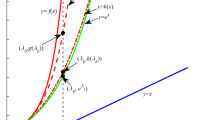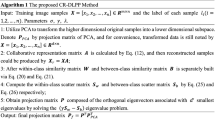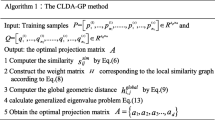Abstract
The locality preserving projections (LPP) method is a hot dimensionality reduction method in the machine learning field. But the LPP method has the so-called small-sample-size problem, and its performance is unstable when the neighborhood size parameter k varies. In this paper, by theoretical analysis and derivation, a maximum difference criterion for the LPP method is constructed, and then a simple and robust LPP method has been proposed, called Locality Preserving Projections based on the approximate maximum difference criterion (LPPMDC). Compared with the existing approaches to solve the small-sample-size problem of LPP, the proposed LPPMDC method has three superiorities: (1) it has no the small-sample-size problem and can get the better performance, (2) it is robust to neighborhood size parameter k, (3) it has low computation complexity. The experiments are performed on the three face databases: ORL, Georgia Tech, and FERET, and the results demonstrate that LPPMDC is an efficient and robust method.












Similar content being viewed by others
Explore related subjects
Discover the latest articles, news and stories from top researchers in related subjects.References
He X, Niyogi P (2004) Locality preserving projections. Adv Neural Inf Process syst (NIPS) 16:153–160
Belkin M, Niyogi P (2001) Laplacian eigenmaps and spectral techniques for embedding and clustering. In: proceedings of the neural information processing systems, pp. 585-591
Huang S, Elgammal A, Lu JW, Yang D et al (2015) Cross-speed gait recognition using speed-invariant gait templates and globality-locality preserving projections. IEEE Trans Inf Forensics Sec 10(10):2071–2083
Kong D, Zhu J, Duan C, Lu L, Chen D (2021) Surface roughness prediction using kernel locality preserving projection and bayesian linear regression. Mech Syst Signal Process 152(2):107474
Ran R, Ren Y, Zhang S, Fang B (2021) A novel discriminant locality preserving projections method. J Math Imaging Vis 63(5):541–554
Turk M, Pentland A (1991) Eigenfaces for recognition. J Cogn Neurosci 3(1):71–86
Fisher RA (1936) The use of multiple measurements in taxonomic problems. Ann Eugenics 7:179–188
Rao CR (1948) The utilization of multiple measurements in problems of biological classification. J R Stat Soc B 10:159–203
He X, Yan S, Hu Y, Niyogi P, Zhang H (2005) Face recognition using Laplacianfaces. IEEE Trans Pattern Anal Mach Intell 27(3):328–340
Wang S, Yan S, Yang J et al (2014) A general exponential framework for dimensionality reduction. IEEE Trans Image Process 23(2):920–930
Cai D, He X, Han J(2007) Spectral regression for efficient regularized subspace learning. In: IEEE conference computer vision (ICCV), Rio de Janeiro, Brazil, pp. 1–8
Lu J, Tan Y (2010) Regularized Locality Preserving Projections and Its Extensions for Face Recognition. IEEE Trans Syst Man Cybern Part B Cybern 40(3):963–985
Wei W, Dai H, Liang W (2020) Regularized least squares locality preserving projections with applications to image recognition. Neural Netw 128(7):322–330
Zhu L, Zhu S (2007) Face recognition based on two dimensional locality preserving projections. J Image Graph 12(11):2043–2047
Huxidan J, Gulnaz A (2018) Face recognition based on rearranged modular two dimensional locality preserving projection. Int J Pattern Recognit Artif Intell 32(12):1856016
Wang A, Zhao S, Liu J, Yang J, Chen G (2020) Locality adaptive preserving projections for linear dimensionality reduction. Exp Syst Appl 151:113352
Wen Y, Yang S, Hou L, Zhang H, (2016) Face recognition using locality sparsity preserving projections. In: 2016 international joint conference on neural networks (IJCNN). Vancouver, BC, Cannada, pp 3600–3607
Wang SJ, Chen HL, Peng XJ, Zhou CG (2011) Exponential locality preserving projections for small sample size problem. Neurocomputing 74(17):3654–3662
Zhang TP, Fang B, Tang YY, Shang Z, Xu B (2010) Generalized discriminant analysis: a matrix exponential approach. IEEE Trans System Man Cybern B Cybern 40(1):186–197
Ran R, Fang B, Wu X (2019) Exponential neighborhood preserving embedding for face recognition. IEICE Trans Inf Syst 101(5):1410–1420
Huang S, Zhuang L (2016) Exponential discriminant locality preserving projection for face recognition. Neurocomputing 208:373–377
Lu G, Wang Y, Zou J (2018) Matrix exponential based discriminant locality preserving projections for feature extraction. Neural Netw 97:127–136
Dornaika F, Bosaghzadeh A (2013) Exponential local discriminant embedding and its application to face recognition. IEEE Trans Cybern 43(3):921–934
Dornaika F, Traboulsi YE (2017) Matrix exponential based semi-supervised discriminant embedding for image classification. Pattern Recogni 61:92–103
Ran R, Fang B, Zhang S et al (2019) Face recognition based on exponential neighborhood preserving discriminant embedding. J Comput (Taiwan) 30(6):1–14
Golub GH, Loan CF (1983) Matrix computation. The Johns Hopkins University Press, Baltimore
Sun JG (2001) Matrix perturbation analysis. Science Press, Beijing
Xu C, Liao M, Li P et al (2019) \( PD^9 \) control strategy for a fractional-order chaotic financial model. Complexity 2019:1–14
Pratap A et al (2020) Mittag-Leffler stability and adaptive impulsive synchronization of fractional order neural networks in quaternion field. Math Methods Appl Sci 7:1–31
Yu F, Qian S, Chen X, Huang Y, Liu L, Shi C et al (2020) A new 4d four-wing memristive hyperchaotic system: dynamical analysis, electronic circuit design, shape synchronization and secure communication. Int J Bifurcat Chaos 30(10):1–20
Yu F, Liu L, He B, Huang Y, Shi C, Cai S et al (2019) Analysis and fpga realization of a novel 5d hyperchaotic four-wing memristive system, active control synchronization, and secure communication application. Complexity 2019:1–18
Yu F, Liu L, Shen H, Zhang Z, Huang Y, Shi C et al (2020) Dynamic analysis, circuit design, and synchronization of a novel 6d memristive four-wing hyperchaotic system with multiple coexisting attractors. Complexity 2020:1–17
Stewart GW (1998) Matrix algorithms volume I: basic decompositions. SIAM, Philadelphia
Cai D, He XF, Han JW (2007) Spectral regression: a unified subspace learning framework for content-based image retrieval. In: proceedings of the 15th ACM international conference on multimedia, pp. 403-412
Higham N (2005) The scaling and squaring method for the matrix exponential revisited. SIAM J Matrix Anal Appl 26(4):1179–1196
Stewart GW (2001) Matrix algorithms volume II: eigensystems. SIAM, Philadelphia
Sim T, Baker S, Bsat M (2003) The CMU pose, illumination, and expression database. IEEE Trans Pattern Anal Mach Intell 25(12):1615–1618
Phillips PJ, Moon H, Rizvi SA, Rauss PJ (2000) The FERET evaluation methodology for face-recognition algorithms. IEEE Trans Pattern Anal Mach Intell 22(10):1090–1104
Cai D, He XF, Han JW (2007) Isometric projection. In: proceedings of AAAI, pp. 528-533
He XF, Cai D, et al. (2005) Neighborhood preserving embedding. In: proceedings conference on computer vision (ICCV), Beijing, China, pp. 1208–1213
Kokiopoulou E, Saad Y (2007) Orthogonal neighborhood preserving projections: a projection-based dimensionality reduction technique. IEEE Trans Pattern Anal Mach Intell 29(12):2143–2156
Zhang T, Yang J, Zhao D, Ge X (2007) Linear local tangent space alignment and application to face recognition. Neurocomputing 70:1547–1553
Acknowledgements
This work was supported by National Natural Science Foundation of China under grant 61876026, Humanities and Social Sciences Project of the Ministry of Education of China under grant 20YJAZH084, Chongqing Technology Innovation and Application Development Project under Grant cstc2020jscx-msxmX0190 and cstc2019jscx-mbdxX0061, Project of Natural Science Foundation Project of CQ CSTC of China under grant cstc2016jcyjA0419 and cstc2017jcyjAX0316, and Science and Technology Research Program of Chongqing Municipal Education Commission under grant KJZD-K202100505.
Author information
Authors and Affiliations
Corresponding author
Additional information
Publisher's Note
Springer Nature remains neutral with regard to jurisdictional claims in published maps and institutional affiliations.
Rights and permissions
About this article
Cite this article
Ran, R., Qin, H., Zhang, S. et al. Simple and Robust Locality Preserving Projections Based on Maximum Difference Criterion. Neural Process Lett 54, 1783–1804 (2022). https://doi.org/10.1007/s11063-021-10706-4
Accepted:
Published:
Issue Date:
DOI: https://doi.org/10.1007/s11063-021-10706-4




